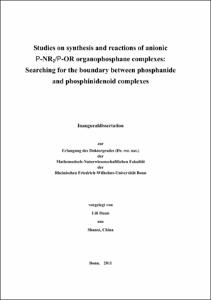Studies on synthesis and reactions of anionic P-NR2/P-OR organophosphane complexesSearching for the boundary between phosphanide and phosphinidenoid complexes

Studies on synthesis and reactions of anionic P-NR2/P-OR organophosphane complexes
Searching for the boundary between phosphanide and phosphinidenoid complexes

| dc.contributor.advisor | Streubel, Rainer | |
| dc.contributor.author | Duan, Lili | |
| dc.date.accessioned | 2020-04-17T08:39:22Z | |
| dc.date.available | 2020-04-17T08:39:22Z | |
| dc.date.issued | 15.11.2011 | |
| dc.identifier.uri | https://hdl.handle.net/20.500.11811/5061 | |
| dc.description.abstract | This thesis was focused on the studies of synthesis and reactivity of the first Li/OR phosphinidenoid complexes, in pursuit of the boundary between phosphanide complex and phosphinidenoid complex chemistry. First, the three modified methodologies were used to generate the precursors – P-functional phosphane complexes. Then subjection of P-functional phosphane complexes to LDA (lithium diisopropylamide) in presence of 12-crown-4 at –78°C led to the Li/OR phosphinidenoid complexes: bearing a downfield 31P chemical shift, combined with a small tungsten-phosphorus coupling constants. But an unexpected decomposition product was observed in the deprotonation of P-acetyl phosphane complex, in which a P–H and a P–O–Li moiety were contained in one molecule. Again, the deprotonation of P-acetyl phosphane complex without 12-crown-4 gave rise to the first observation of phosphorus-lithium coupling (quart, δ = 220 ppm, 1J(P,Li) = 40.7 Hz). Moreover, the effects of reaction conditions (e.g. different bases, different co-ligands, etc) on the NMR signature and thermal stability of Li/OR phosphinidenoid complexes were investigated. However, in all of cases, the 31P NMR signature showed little (or no) difference, therefore it was deduced that the Li/OR phosphinidenoid complexes might be an ion pair complex, in which metal cations bear the co-ligand (such as 12-crown-4 or cryptand[2.1.1]) or solvents and P-OR phosphanide complexes as anions. This assumption was confirmed additionally by the single-crystal X-ray analysis of [N,N-di-tert-butyl-imidazolium] stabilized phosphinidenoid complex. In the chapter 7, reactivity studies of Li/OR phosphinidenoid complexes were introduced. In most cases, the “phosphanide-type” reactivity was displayed. Only in the thermal reaction of Li/OPh derivative, the “phosphinidene-type” reactivity was revealed, which was explained by the observation of cyclotriphosphane compound, although the mechanism was not clear. Besides, for Li/OMe phosphinidenoid complex, the redox reactivity was observed and also confirmed by the ESR measurement. | en |
| dc.language.iso | eng | |
| dc.rights | In Copyright | |
| dc.rights.uri | http://rightsstatements.org/vocab/InC/1.0/ | |
| dc.subject.ddc | 540 Chemie | |
| dc.title | Studies on synthesis and reactions of anionic P-NR2/P-OR organophosphane complexes | |
| dc.title.alternative | Searching for the boundary between phosphanide and phosphinidenoid complexes | |
| dc.type | Dissertation oder Habilitation | |
| dc.publisher.name | Universitäts- und Landesbibliothek Bonn | |
| dc.publisher.location | Bonn | |
| dc.rights.accessRights | openAccess | |
| dc.identifier.urn | https://nbn-resolving.org/urn:nbn:de:hbz:5N-26980 | |
| ulbbn.pubtype | Erstveröffentlichung | |
| ulbbnediss.affiliation.name | Rheinische Friedrich-Wilhelms-Universität Bonn | |
| ulbbnediss.affiliation.location | Bonn | |
| ulbbnediss.thesis.level | Dissertation | |
| ulbbnediss.dissID | 2698 | |
| ulbbnediss.date.accepted | 25.10.2011 | |
| ulbbnediss.fakultaet | Mathematisch-Naturwissenschaftliche Fakultät | |
| dc.contributor.coReferee | Beck, Johannes |
Files in this item
This item appears in the following Collection(s)
-
E-Dissertationen (4337)




